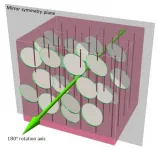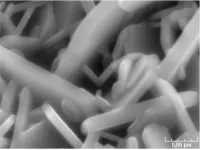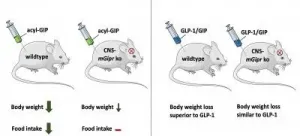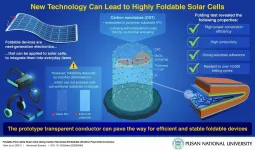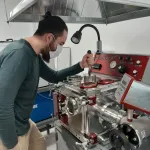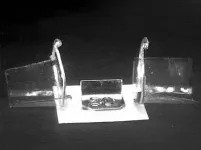Texas A&M researchers discover energy drinks' harmful effects on heart
Popular energy drinks may give you a boost, but they may also contribute to possible serious heart conditions, findings show
2021-02-10
(Press-News.org) A team of researchers, led by a Texas A&M University professor, has found that some energy drinks have adverse effects on the muscle cells of the heart.
The study, led by Dr. Ivan Rusyn, a professor in the Veterinary Integrative Biosciences (VIBS) Department at the Texas A&M College of Veterinary Medicine & Biomedical Sciences (CVMBS), was published in Food and Chemical Toxicology. In it, researchers observed cardiomyocytes - human heart cells grown in a laboratory - exposed to some energy drinks showed an increased beat rate and other factors affecting cardiac function.
When placed in the context of the human body, consumption of these beverages has been linked to improper beating of the heart, cardiomyopathy (disease of the heart muscle which makes it difficult for the heart to pump blood), increased blood pressure, and other heart conditions.
With the global sales of energy drinks estimated at $53 billion in 2018 and rapidly growing, it is important to understand the potential unintended health consequences associated with these beverages, according to Rusyn.
"Because the consumption of these beverages is not regulated and they are widely accessible over the counter to all age groups, the potential for adverse health effects of these products is a subject of concern and needed research," Rusyn said. "Indeed, the consumption of energy drinks has been associated with a wide range of adverse health effects in humans, many of them are concerning the effects on the heart."
Researchers evaluated 17 widely available over-the-counter brands. They then treated cardiomyocytes with each drink.
Researchers also studied the composition of the energy drinks using novel methods. By comparing the effects and differing ingredient concentrations in each drink, they were able to infer which ingredients may be contributing more to adverse effects on the treated cardiomyocytes. Using mathematical models, researchers determined that the possible presence of theophylline, adenine and azelate, substances which can have negative effects on the heart.
"Little is known about the ingredients that may contribute to the adverse effects of energy drinks on the heart," Rusyn said. "Specifically, the evidence for cardiovascular effects from studies in humans remains inconclusive, as the controlled clinical trials were largely limited in the number of participants. They were tested only a limited number of energy drink types, and are difficult to compare directly, because they employed different methods to evaluate the function of the cardiovascular system."
Further research is warranted on the ingredients identified in this study to ensure the safety of their consumption, especially by consumers with pre-existing health conditions.
"This study shows that some of the tested energy drinks may have effects on human cardiomyocytes, and these data corroborate other studies in humans," Rusyn said. "Therefore, we hope that the consumers will carefully weigh the performance-enhancing benefits of these beverages versus the emerging data that suggests that they may have real adverse effects.
"We also hope that the Food and Drug Administration takes a closer look at whether these beverages may need to be carefully reviewed with respect to possible labeling of their adverse health effects, and whether certain age groups and susceptible sub-populations should be advised against consumption of these beverages."
INFORMATION:
ELSE PRESS RELEASES FROM THIS DATE:
2021-02-10
A team at the University of Colorado Boulder has designed new kinds of liquid crystals that mirror the complex structures of some solid crystals--a major step forward in building flowing materials that can match the colorful diversity of forms seen in minerals and gems, from lazulite to topaz.
The group's findings, published today in the journal Nature, may one day lead to new types of smart windows and television or computer displays that can bend and control light like never before.
The results come down to a property of solid crystals that will be familiar to many chemists and gemologists: Symmetry.
Ivan Smalyukh, ...
2021-02-10
Israelis across the political spectrum prefer the status quo to the two-state solution, and Palestinians are only willing to accept a two-state solution that Israelis will be unable to accept, according to a new RAND Corporation report that assesses whether there are any alternative solutions to the conflict that average Israelis and Palestinians would support.
Derived from a series of innovative, structured focus group discussions, the report suggests that the Biden Administration's recent reaffirmation of U.S. policy to support a "mutually agreed two-state solution, one in which Israel lives in peace ...
2021-02-10
The number of people who own electric vehicles (EVs) is increasing, but they face a conundrum: Unlike those who own gasoline-burning cars, EV owners can't just pop down to the corner gas station for a fill-up. Particularly in rural areas, charging stations can be few and far between.
Joshua Pearce, Richard Witte Endowed Professor of Materials Science and Engineering and professor of electrical and computer engineering at Michigan Technological University, hopes to change that.
In a model outlined in a paper in the journal Renewable Energy, Pearce and his co-author, graduate student Swaraj Sanjay Deshmukh, note the untapped potential of retail parking lot solar photovoltaic awnings.
The study investigates the energy-related benefits ...
2021-02-10
A team of researchers from Immanuel Kant Baltic Federal University obtained magnetic nanoparticles using sweet flag (Acorus calamus). Both the roots and the leaves of this plant have antioxidant, antimicrobial, and insecticide properties. The extract of sweet flag was used as a non-toxic reagent for the manufacture of coated particles. The authors of the work also showed the efficiency of the new nanoparticles against several types of pathogenic fungi that damage cultivated plants. A technology developed by the team provides for the manufacture of nanoparticles from a cheap plant-based raw material and reduces the harmful effect of reagents on the environment.
Because of their unique properties, nanoparticles are used in many areas, from medicine to oil production. ...
2021-02-10
The gram-negative bacteria Helicobacter pylori (H. pylori) colonize the stomachs of the majority of the world's population. Although most people may never experience major complications due to the pathogen, H. pylori infections increase the risk of certain types of gastric cancer, as well as other illnesses such as peptic ulcers and gastritis.
Currently, H. pylori infections are treatable with a cocktail of antibiotics, but the rapid emergence of antibiotic resistance in H. pylori is a significant concern. To counter these threats, Pushkar Lele, assistant professor in the Artie McFerrin Department of Chemical Engineering at Texas A&M University, investigated how ...
2021-02-10
The GIP receptor in the central nervous system plays a crucial role in the regulation of body weight and food intake. This is shown by a recent study by Helmholtz Zentrum München, ETH Zurich and the German Center for Diabetes Research (DZD). The study, which has now been published in 'Cell Metabolism', identifies new targets for the development of a drug treatment for obesity and type 2 diabetes.
Dual-agonists targeting the receptors for Glucagon-like peptide 1 (GLP-1) and glucose-dependent insulinotropic polypeptide (GIP) are promising novel drug candidates for the treatment of obesity and diabetes. The new study shows how GIP decreases body weight. GIP is a hormone produced by ...
2021-02-10
With the recent development of foldable mobile phone screens, research on foldable electronics has never been so intensive. One particularly useful application of the foldable technology is in solar panels.
Current solar cells are restricted to rigid, flat panels, which are difficult to store in large numbers and integrate into everyday appliances, including phones, windows, vehicles, or indoor devices. But, one problem prevents this formidable technology from breaking through: to be integrated into these items, solar cells need to be foldable, to bend at will repeatedly without breaking. Traditional conducting materials used in ...
2021-02-10
MAX-phases are the new promising class of artificially created compounds that started to be extensively studied in the last two decades. They are a family of ternary layered compounds with the general formula Mn+1AXn (n = 1, 2, 3 ...), where M is an early transition metal (Sc, Ti, V, Cr, et cetera; elements from the left side of the d-block of the periodic table from group III to group VII); A -- an element from group IIIA or IVA (the most common are Al, Ga, Si, Ge); X is carbon or nitrogen, that is, the MAX phase is carbide or nitride, respectively.
Due to their structure and composition, ternary layered carbides and nitrides of d- and p-elements have a unique combination of physical properties. These compounds have high electrical and heat conductivity ...
2021-02-10
One of the many mysteries still surrounding COVID-19 is why some people experience only mild, flu-like symptoms, whereas others suffer life-threatening respiratory problems, vascular dysfunction and tissue damage. Now, researchers reporting in ACS' Analytical Chemistry have used a combination of metabolomics and machine learning to identify possible biomarkers that could both help diagnose COVID-19 and assess the risk of developing severe illness.
Although some pre-existing conditions, such as diabetes or obesity, can increase the risk of hospitalization and death from COVID-19, some otherwise healthy people have also experienced ...
2021-02-10
If you watch the leaves of a plant long enough, you may see them shift and turn toward the sunlight through the day. It happens slowly, but surely.
Some man-made materials can mimic this slow but steady reaction to light energy, usually triggered by lasers or focused ambient light. New research from the University of Pittsburgh and Carnegie Mellon University has discovered a way to speed up this effect enough that its performance can compete against electrical and pneumatic systems.
"We wanted to create machines where light is the only source of energy and direction," explained M. Ravi Shankar, professor of industrial engineering and senior author of the paper. "The challenge is that while we could get some movement and actuation with light-driven polymers, ...
LAST 30 PRESS RELEASES:
[Press-News.org] Texas A&M researchers discover energy drinks' harmful effects on heart
Popular energy drinks may give you a boost, but they may also contribute to possible serious heart conditions, findings show
